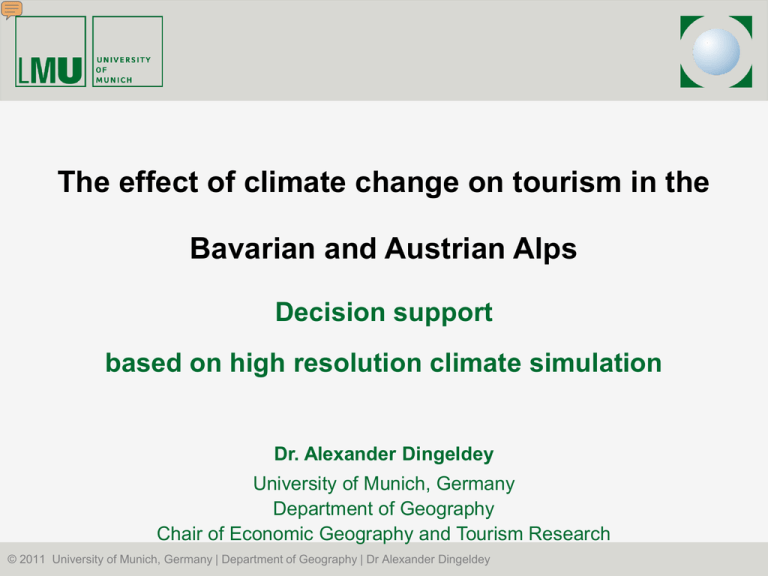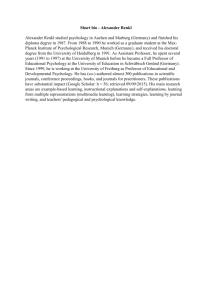The effect of climate change on tourism in the Decision support
advertisement

The effect of climate change on tourism in the Bavarian and Austrian Alps Decision support based on high resolution climate simulation Dr. Alexander Dingeldey University of Munich, Germany Department of Geography Chair of Economic Geography and Tourism Research © 2011 University of Munich, Germany | Department of Geography | Dr Alexander Dingeldey Climate change and tourism in the Alps Bavarian and Austrian Tourism Regions – the future © 2011 University of Munich, Germany | Department of Geography | Dr Alexander Dingeldey 2 Overview of the project GLOWA-Danube Investigation area © 2011 University of Munich, Germany | Department of Geography | Dr Alexander Dingeldey 3 Overview of the project GLOWA-Danube Source: Final Report GLOWA Phase I, adapted. © 2011 University of Munich, Germany | Department of Geography | Dr Alexander Dingeldey Climate Change according to IPCC Different Scenarios Increase of the mean temperature from 1.4°C to 6.4°C till 2100 Increase of the mean temperature from 0.1°C to 0.4°C every 10 years Increase of daily maximum and minimum temperatures More “Hot days” Fewer “Cold Days” More humidity during the winter Increase of the altitude for „snow-reliability” form 1200m to 1500m © 2011 University of Munich, Germany | Department of Geography | Dr Alexander Dingeldey Challenges Climate-Simulation-Models work on a very large scale Climate-Simulation on small scales and mountain areas is very complicated The impact of the climate change is regionally different © 2011 University of Munich, Germany | Department of Geography | Dr Alexander Dingeldey The GLOWA-Danube Team © 2011 University of Munich, Germany | Department of Geography | Dr Alexander Dingeldey 7 Models within GLOWA_Danube Environment Human © 2011 University of Munich, Germany | Department of Geography | Dr Alexander Dingeldey 8 Framework Environment Human © 2011 University of Munich, Germany | Department of Geography | Dr Alexander Dingeldey 9 Framework Environment Human © 2011 University of Munich, Germany | Department of Geography | Dr Alexander Dingeldey 10 Tourism Model Actor classes ski areas, golf courses, swimming pools, gastronomy, hotel business. © 2011 University of Munich, Germany | Department of Geography | Dr Alexander Dingeldey 11 Model concept © 2011 University of Munich, Germany | Department of Geography | Dr Alexander Dingeldey 12 Model concept © 2011 University of Munich, Germany | Department of Geography | Dr Alexander Dingeldey 13 Model concept © 2011 University of Munich, Germany | Department of Geography | Dr Alexander Dingeldey 14 Model concept © 2011 University of Munich, Germany | Department of Geography | Dr Alexander Dingeldey 15 Model concept © 2011 University of Munich, Germany | Department of Geography | Dr Alexander Dingeldey 16 Simulation Area – Golf Courses Bavaria Czech Republic Golf Courses Number of Holes Germany Rivers Simulation-Area State-Boundaries Austria Country-Boundaries Switzerland Italy Source: Own Research. © 2011 University of Munich, Germany | Department of Geography | Dr Alexander Dingeldey Kilometers Kilometers Simulation Area – Swimming Pool Bavaria Czech Republic Swimming Pools Germany Outdoor Pool In-&Outtdoor Pool Indoor Pool Water Park Thermal Spas Rivers Simulation-Area Austria State-Boundaries Country-Boundaries Switzerland Italy Quelle: Eigene Recherchen. © 2011 University of Munich, Germany | Department of Geography | Dr Alexander Dingeldey Kilometers Simulation Area – Skiing Areas Bavaria Czech Republic Capacity in Pers/h Germany Germany No data Rivers Simulation-Area State-Boundaries Austria Country-Boundaries Switzerland Italy Source: Own Research. © 2011 University of Munich, Germany | Department of Geography | Dr Alexander Dingeldey Kilometers Dependency on winter tourism Ski dependant bednights: None Under 25% 25%-75% 75%-100% © 2011 University of Munich, Germany | Department of Geography | Dr Alexander Dingeldey 20 How do guest inform themselfs? Source: Own Research, Tyrol 2005 N=275 © 2011 University of Munich, Germany | Department of Geography | Dr Alexander Dingeldey 21 How do guests react? Source: Own Research, Tyrol 2005 N=275 © 2011 University of Munich, Germany | Department of Geography | Dr Alexander Dingeldey 22 Spatial concept Proxel (Process-Pixel) © 2011 University of Munich, Germany | Department of Geography | Dr Alexander Dingeldey 23 Distribution on Proxels Populalation 1 to 800 801 to 2900 Over 2900 Share of total Population of Starnberg Community Source: Topographical map with own adaptions © 2011 University of Munich, Germany | Department of Geography | Dr Alexander Dingeldey Example of a Deep Actor Skiing-Area Skiing Area Out of Service Start of Season? Yes No Is there enough Snow? Yes No Sking area In Service IF Current_date >= Start of Season (15Dez) AND Current_date <= End of Season (15Apr) AND Natural_Snow_Cover >= 30 cm THEN SkiingArea.open ELSE SkiingArea.close; Source: Own Resaerch © 2011 University of Munich, Germany | Department of Geography | Dr Alexander Dingeldey Example of a Deep Actor Skiing-Area Skiing-Area with artificial Snowmaking Open SnowMaking Open Source: Own research Artificial Snow Status Artificial Snow in m3 Snowmaking © 2011 University of Munich, Germany | Department of Geography | Dr Alexander Dingeldey Example of a Ski Area Status of Skiing areas within 20 km Distance Status of Swimming Pools within 20 km Distance Status of Golf Courses within 30 km Distance Availibility of Drinking Water within 30 km Discance Monthly Average Temperature Simulation for ~2100 Communities Source: Own Calculation – Climate Scenario: REMO, Climate Variant: Baseline © 2011 University of Munich, Germany | Department of Geography | Dr Alexander Dingeldey 27 Scenario kit Climate trend Climate variant Societal scenario IPCC regional Baseline Baseline REMO regional 5 warm winters Open competition MM5 regional 5 hot summers Public Welfare Extrapolation 5 dry years © 2011 University of Munich, Germany | Department of Geography | Dr Alexander Dingeldey 28 Simulated Opertation Days of Skiing Areas Average Operating Days within the States 2012 - 2059 120 Bavaria South Baseline Bavaria South Liberalisation Average Operation Days 100 Bavaria South Sustainibility 80 Bavaria North Baseline Bavaria North Liberalisation 60 Bavaria North Sustainibility 40 Tyrol Baseline 20 Tyrol Liberalisation Tyrol Sustainibility 0 2012 2017 2022 2027 2032 2037 2042 2047 2052 Source: Own simulation, Remo Scenario, Baseline Variant © 2011 University of Munich, Germany | Department of Geography | Dr Alexander Dingeldey 2057 Simulated Opertation Days of Skiing Areas (Baseline-Scenario) Average Operating Days of selected Skiing Areas 2012-2059 140 Hoher Bogen 120 Average Operation Days Pröllerlifte 100 Brauneck 80 Christlum 60 Kitzbühel Zugspitzplatt 40 Kitzbühel 20 Silvretta Arena 0 2012 2017 2022 2027 2032 2037 2042 2047 2052 Source: Own simulation, Remo Scenario, Baseline Variant © 2011 University of Munich, Germany | Department of Geography | Dr Alexander Dingeldey 2057 Simulated Tourism Demand in the Upper Danube Catchment Simulated Number of Bednights per Year 2011- 2059 300000000.0 Baseline Baseline Number of Bednights 250000000.0 Hot Summers Baseline 200000000.0 Baseline Liberalisation 150000000.0 Hot Summer Sustainibility 100000000.0 Baseline Sustainibility 50000000.0 Hot Summer Liberalisation .0 2011 2021 2031 2041 Source: Own simulation, Remo Scenario © 2011 University of Munich, Germany | Department of Geography | Dr Alexander Dingeldey 2051 Simulated Tourism Demand in the Upper Danube Catchment Simulated Number of Bednights per Month 2011-2059 40000000 211 Baseline 35000000 Number of Bednights Liberalisation 212 30000000 Sustainibility 213 25000000 20000000 15000000 10000000 5000000 0 2059_1 2057_1 2055_1 2053_1 2051_1 2049_1 2047_1 2045_1 2043_1 © 2011 University of Munich, Germany | Department of Geography | Dr Alexander Dingeldey 2041_1 2039_1 2037_1 2035_1 2033_1 2031_1 2029_1 2027_1 2025_1 2023_1 2021_1 2019_1 2017_1 2015_1 2013_1 2011_1 Source: Own simulation, Remo Scenario, Baselnie Variant Selected Results Simulated threat level of climate change 2050/51 to 2059/60 – number of ski areas 300 Number of Ski Areas 250 Low 200 98 104 135 150 50 47 100 50 Elevated 36 102 82 105 Severe 0 Baseline Open Competition Public Welfare Societal Scenario Source: Own Calculation – Climate Scenario: REMO, Climate Variant: Baseline © 2011 University of Munich, Germany | Department of Geography | Dr Alexander Dingeldey 33 Selected Results Simulated threat level of climate change 2050/51 to 2059/60 – carrying capacity of ski areas Capacity sum of skiing areas (pers/h) 3,000,000 2,500,000 Low 2,000,000 1,500,000 Elevated 1,000,000 Severe 500,000 0 Baseline Open Competition Public Welfare Societal Scenario Source: Own Calculation – Climate Scenario: REMO, Climate Variant: Baseline © 2011 University of Munich, Germany | Department of Geography | Dr Alexander Dingeldey 34 Operating Costs © 2011 University of Munich, Germany | Department of Geography | Dr Alexander Dingeldey 35 Operating Costs © 2011 University of Munich, Germany | Department of Geography | Dr Alexander Dingeldey 36 Selected Results Threat level of ski areas and simulated development of overnight tourism Source: Own Calculation – Climate Scenario: REMO, Climate Variant: Baseline © 2011 University of Munich, Germany | Department of Geography | Dr Alexander Dingeldey 37 Selected Results – Water consumption of Golf Courses Average water consumption of golf courses per district in in m³/year from 2050 till 2059 in the scenaro REMO regional – baseline – Societal Scenario Performance Societal Scenaro Public welfare Golf Course © 2011 University of Munich, Germany | Department of Geography | Dr Alexander Dingeldey 38 Selected Results – Water consumption of Golf Courses Average water consumption of golf courses per district in in m³/year from 2050 till 2059 in the scenaro REMO regional – 5 hot summers– Societal Scenario Performance Societal Scenaro Public welfare Golf Course © 2011 University of Munich, Germany | Department of Geography | Dr Alexander Dingeldey 39 Perfect days for skiing Variable Value No precipitation precipitation sum = 0 Complete snow cover in the surrounding snow height > 0 All lifts are operating yes Enough snow in the ski area yes Enogh artificial snow yes Comfortable temperature -5 bis +5 °C Sunshine duration (clear sky) over 5 h/day Wind speed max 10 m/s © 2011 University of Munich, Germany | Department of Geography | Dr Alexander Dingeldey 40 Perfect days for skiing Average number of perfect ski days per season (REMO regional – Baseline – Baseline) 2011/12 bis 2018/19 2049/50 bis 2058/59 © 2011 University of Munich, Germany | Department of Geography | Dr Alexander Dingeldey 41 Conclusions Different effects of the climate change on tourism The attractiveness of regions with a high percentage of leisure and recreational tourism within Austria, Germany and Switzerland will increase with the rising average temperature during the summer Bigger, better equipped and higher located skiing-areas will be more attractive to tourists. The Climate change will enforce concentration of skiing areas Bigger, better equipped and higher located skiing-areas will get more attractiveness Smaller skiing-areas with lower snow reliability will be very hard to operate Climate change scenario leads the trend way, but societal conditions wield relatively great influence © 2011 University of Munich, Germany | Department of Geography | Dr Alexander Dingeldey Further References www.glowa-danube.de © 2011 University of Munich, Germany | Department of Geography | Dr Alexander Dingeldey 43 © 2011 University of Munich, Germany | Department of Geography | Dr Alexander Dingeldey 44 2011 University of Munich, Germany | Department of Geography | Dr Alexander Dingeldey © Lehrstuhl für Wirtschaftsgeographie und Tourismusforschung Jahrestagung Arbeitskreis Freizeit- und Tourismusgeographie




